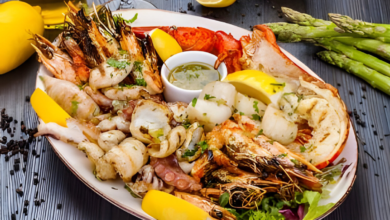Italian Restaurant Experience: Discover Authentic Flavors in Italy

Introduction Italian Restaurant Experience
In today’s blog post, we will delve into the rich and tantalizing world of Italian cuisine. From the rustic flavors of Northern Italy to the sun-drenched tastes of Southern Italy, we will take you on a culinary journey like no other. Unveiling the essence of Italian cuisine, we’ll explore the deep-rooted gastronomic heritage, the cultural significance of food, and the pivotal role Italian restaurants play in preserving tradition. So sit back, relax, and get ready to embark on a mouthwatering adventure to discover authentic flavors in Italy.
Unveiling the Essence of Italian Cuisine
Italian cuisine is renowned worldwide for its simplicity, quality ingredients, and passion for flavor. It is a cuisine deeply ingrained in the cultural fabric of Italy, with a history spanning centuries. Each region boasts its own culinary traditions, reflecting the local ingredients and cultural influences. From the fresh seafood of the Mediterranean to the hearty dishes of the Alps, Italian cuisine celebrates diversity while maintaining a truly authentic experience.
A Brief Overview of Italian Gastronomic Heritage
Before we dive deeper into the world of Italian restaurants, let’s take a moment to appreciate the gastronomic heritage that has shaped this exquisite cuisine. Italy’s geographical location and rich history have contributed to its diverse culinary landscape. Ancient Roman techniques, medieval traditions, and Mediterranean flavors have all played a part in molding the distinct flavors found in Italian dishes today. Italy’s world-renowned culinary excellence didn’t happen overnight; it’s a result of centuries of refinement and passion for food.
Embracing the Culture Through Food
In Italy, food isn’t merely sustenance; it’s a way of life. Italians view meals as social gatherings, treasured moments to connect with loved ones and embrace the local culture. Traditional Italian cuisine not only nourishes the body but also feeds the soul. It’s about savoring the moment, indulging in the flavors, and appreciating the craftsmanship that goes into each dish. Whether it’s a simple plate of pasta or an elaborate multi-course feast, every meal in Italy is an opportunity to celebrate life.
The Role of Italian Restaurants in Preserving Tradition
Italian restaurants are the gatekeepers of tradition, preserving and sharing the authentic flavors of Italy with the world. They serve as culinary ambassadors, providing a genuine taste of Italy’s diverse regional cuisines. With their dedication to quality ingredients, skilled chefs, and warm hospitality, Italian restaurants bring the essence of Italy to diners worldwide. Let’s now embark on a culinary journey through the traditional Italian restaurants that transport us to the heart of Italy.
Traditional Italian Restaurants: A Culinary Journey
The Ambiance of Italian Eateries
Stepping into a traditional Italian restaurant is like entering another world. From the moment you walk through the doors, you are immersed in the essence of Italy. The captivating decor, inspired by Italy’s storied history and picturesque landscapes, transports you to the winding streets of Florence or the romantic canals of Venice. The warm hospitality of the staff, with their genuine smiles and attentive service, makes you feel like an honored guest.
Captivating Decor: Transporting You to Italy
Italian restaurants pride themselves on creating an authentic atmosphere that mirrors the beauty of their homeland. From rustic stone walls adorned with colorful artwork to charming terraces overlooking the countryside, the ambiance of Italian eateries adds a touch of enchantment to your dining experience. The carefully curated interior design pays homage to Italy’s rich cultural heritage, enabling customers to feel as though they have been transported to the heart of this beautiful country.
Warm Hospitality: A Key Ingredient
One of the distinguishing features of Italian restaurants is the warm and inviting atmosphere they create. The genuine hospitality and friendly demeanor of the staff make diners feel welcomed and cherished. Italians are famous for their love of good company and conversation, and this extends to their restaurant culture. Whether it’s a family-run trattoria or an upscale ristorante, you can expect to be treated with warmth and hospitality, making your dining experience all the more memorable.
The Significance of a Relaxed Dining Atmosphere
Italian restaurants embrace a relaxed dining atmosphere, encouraging diners to take their time and truly enjoy the experience. The concept of “slow food” is deeply ingrained in Italian culture, emphasizing the importance of savoring the moment and taking pleasure in every bite. Unlike the hurried pace of many modern dining establishments, Italian restaurants provide a space for you to unwind, connect with your dining companions, and indulge in the rich flavors of Italy at a leisurely pace.
Masterful Italian Chefs: Artists in the Kitchen
Italian cuisine owes much of its fame to the masterful chefs who bring these delectable dishes to life. Just like artists, Italian chefs skillfully layer flavors, balance ingredients, and create culinary works of art. They possess a deep understanding of traditional cooking techniques, passed down through generations, and have a profound respect for the quality and seasonality of ingredients.
Mastery of Traditional Cooking Techniques
Italian chefs have honed their skills in the art of traditional cooking techniques, employing time-tested methods that have been refined over centuries. From hand-rolling pasta to slow-cooking ragù, these techniques are part of the fabric of the Italian culinary tradition. Chefs carry the torch of tradition and continue to perfect their craft, using age-old secrets to create dishes that are both comforting and unforgettable.
Incorporating seasonal and local ingredients
Italian cuisine celebrates the vibrant flavors of seasonal and local ingredients. Chefs prioritize local produce, allowing the natural flavors to shine in their dishes. Whether it’s the freshness of ripe tomatoes in a Caprese salad or the earthy aroma of truffles in a risotto, the use of local ingredients ensures that each plate is a testament to the bountiful flavors of the region.
The Art of Balancing Flavors in Authentic Italian Dishes
One of the hallmarks of Italian cuisine is its harmonious balance of flavors. Italian chefs have an innate understanding of how to combine ingredients to create a symphony of taste. From the acidity of tomatoes balancing the richness of mozzarella to the delicate sweetness of fresh basil enhancing the umami of Parmigiano Reggiano, every element in an authentic Italian dish has a purpose.
Menu Delights: Exploring Authentic Italian Fare
Italian menus are a treasure trove of flavors, offering a wide range of delicious dishes that showcase the true essence of Italian cuisine. Let’s explore some of the highlights that you can expect to find on traditional Italian restaurant menus.
Antipasti: A Flavorsome Prelude to the Meal
Antipasti, or appetizers, are a delightful way to kickstart your Italian culinary journey. These small plates offer a variety of flavors and textures, tantalizing your taste buds and preparing your palate for the feast yet to come. From bruschetta topped with fresh tomatoes and fragrant basil to creamy burrata drizzled with olive oil, antipasti embody the simplicity and freshness that Italian cuisine is celebrated for.
Primi Piatti: Pasta and Risotto Galore
No Italian meal is complete without a serving of pasta or risotto. Primi piatti, or first courses, are the heart and soul of Italian cuisine. From the velvety folds of fettuccine Alfredo to the luscious strands of spaghetti carbonara, each pasta dish tells a story of tradition, love, and passion. Risotto, with its creamy texture and infinite flavor possibilities, allows chefs to showcase their creativity while staying true to their Italian culinary heritage.
Secondi Piatti: Savory Delights of Meat and Fish
Secondi piatti, or second courses, offer a hearty selection of meat and fish dishes that delight the senses. From succulent grilled steaks drizzled with olive oil to delicate pan-seared sea bass served with lemon and capers, these dishes showcase the unparalleled quality of Italy’s meat and seafood. Accompanied by perfectly roasted potatoes or a medley of seasonal vegetables, secondi piatti are a celebration of simplicity and timeless flavors.
Wine and Dine: The Perfect Pairing
No Italian dining experience is complete without the perfect wine pairing. Italy’s rich wine culture has contributed to its reputation as a gastronomic paradise. Let’s explore the role of wine in enhancing the flavors of Italian cuisine and discover some popular Italian wine varieties.
Appreciating Italy’s Vast Wine Culture
Wine has a sacred place in Italian culture, and Italian restaurants take great pride in their extensive wine lists. Italians view wine as an integral part of the dining experience, with each region boasting its own unique wine production methods and grape varieties. From the robust reds of Tuscany to the crisp whites of Veneto, Italy offers a vast array of wines just waiting to be enjoyed.
Expert wine selection to complement the cuisine
Italian restaurants employ sommeliers who are well-versed in the art of wine selection. They carefully curate wine lists to ensure that each wine complements the flavors and nuances of the dishes on offer. The sommelier’s expertise can guide you through the world of Italian wines, suggesting the perfect pairing that will elevate your dining experience to new heights.
Insight into Popular Italian Wine Varieties
Italy is home to numerous grape varieties, resulting in a diverse range of wines. Some popular varieties include Sangiovese, Nebbiolo, Barbera, and Montepulciano for red wines, and Pinot Grigio, Vermentino, and Prosecco for white wines. Each variety brings its own distinctive flavors and characteristics, offering wine enthusiasts an opportunity to explore the diverse terroirs that make Italian wines so renowned.
Sweet Temptations: Italian Desserts
No meal is complete without indulging your sweet tooth with a delectable Italian dessert. From the classic favorites to regional specialties, Italian desserts are a heavenly way to end your meal on a sweet note.
Decadent Delicacies: Tiramisu and Panna Cotta
Tiramisu, a creamy concoction of mascarpone cheese, ladyfingers, and coffee, is perhaps one of the most well-known Italian desserts. Its velvety texture and delightful blend of flavors make it a much-loved treat worldwide. Panna cotta, on the other hand, is a silky custard-like dessert often flavored with vanilla or fruits like berries. Both desserts exemplify the elegance and simplicity that Italian cuisine is known for.
Gelato: Italy’s Beloved Frozen Treat
Gelato, Italy’s version of ice cream, is a beloved frozen treat that captures the hearts of locals and tourists alike. Unlike its American counterpart, gelato has a denser texture and a more intense flavor. Italian gelaterias offer a wide array of flavors, from classics like pistachio and stracciatella to innovative creations like lavender honey and salted caramel. A scoop of gelato on a warm summer day is pure bliss.
Regional Specialties to Satisfy Your Sweet Tooth
Italy’s regional diversity extends to its desserts as well. Each region has its own unique sweet specialties that showcase the local flavors and culinary traditions. From cannoli in Sicily to sfogliatelle in Naples, regional desserts provide a glimpse into the cultural richness that defines Italian cuisine.
Discovering Regional Italian Cuisine
Northern Italy: Rustic Flavors Amidst Stunning Landscapes
The northern regions of Italy offer a breathtaking backdrop for unforgettable culinary experiences. Let’s explore some of the culinary delights that await in Lombardy, Emilia-Romagna, and Piedmont.
Lombardy: Risotto and Polenta Delights
Lombardy, with its picturesque lakes and rolling hills, is famous for its rich and comforting dishes. Risotto alla Milanese, a creamy, saffron-infused rice dish, is a Lombardian specialty that embodies the region’s love for simplicity and elegance. Polenta, made from cornmeal, is another staple of Lombardian cuisine, often served with hearty stews or braised meats.
Emilia-Romagna: Home of Parmigiano Reggiano and Balsamic Vinegar
Emilia-Romagna is a gastronomic paradise, renowned for its world-famous Parmigiano Reggiano cheese and balsamic vinegar. Parmigiano Reggiano, known as the “King of Cheeses,” is a hard, nutty cheese that pairs perfectly with cured meats and aged balsamic vinegar. Speaking of vinegar, the region’s traditional balsamic vinegar, aged for years in wooden barrels, adds a complex and tangy flavor to salads and roasted meats.
Piedmont: Truffles and Wines of Excellence
Piedmont, nestled in the foothills of the Alps, is a true culinary treasure. This region is famous for its truffles, which are prized for their earthy and aromatic qualities. Whether shaved over homemade pasta or infused into oils, truffles elevate dishes to new heights. Piedmont is also renowned for its wines, particularly Barolo and Barbaresco. These bold and complex red wines make the perfect accompaniment to Piedmont’s robust cuisine.
Central Italy: The Heart of Italian Culinary Tradition
Central Italy is home to some of Italy’s most iconic dishes, drawing inspiration from ancient Rome and the Renaissance. Let’s explore the culinary wonders of Tuscany, Umbria, and Lazio.
Tuscany: Simplicity and Elegance in Florentine Cuisine
Tuscany’s cuisine is a celebration of simplicity and high-quality ingredients. Florentine steak, a thick and juicy cut of beef, is a true carnivore’s delight. It is often served simply with a drizzle of olive oil and a sprinkle of sea salt, allowing the meat’s natural flavors to shine through. Another Tuscan favorite is ribollita, a hearty vegetable and bread soup that warms the soul on a cold winter’s day.
Umbria: The Green Heart’s Delights
Umbria, known as the “Green Heart of Italy,” offers a taste of authentic rural cuisine. Porchetta, a succulent roast pork seasoned with garlic, herbs, and wild fennel, is a regional specialty that’s hard to resist. Truffle lovers will also find delight in Umbria, as the region is home to black truffles that are showcased in various dishes, including pasta and sauces.
Lazio: The Eternal City’s Timeless Classics
Lazio, the region that encompasses Rome, is a culinary treasure trove filled with timeless classics. Cacio e pepe, a pasta dish made with Pecorino Romano cheese and black pepper, is a simple yet exquisite expression of Roman cuisine. Another famous dish is carbonara, a heavenly combination of pasta, eggs, pecorino cheese, and pancetta. Lazio’s cuisine reflects the city’s rich history and embodies the spirit of La Dolce Vita.
Southern Italy: Sun-Drenched Flavors of the Mediterranean
Campania: Naples and the Birthplace of Pizza
Imagine strolling through the busy streets of Naples, Italy’s third-largest city, with the tantalizing aroma of freshly baked pizza wafting through the air. Campania, the region where Naples is located, is famous for being the birthplace of pizza. It’s here that you can indulge in the true essence of Neapolitan pizza, with its thin, chewy crust, flavorful tomato sauce, and the freshest mozzarella cheese. Be sure to visit pizzerias like Da Michele and Sorbillo, which have been serving pizza for generations, preserving the authentic taste that has made Naples a pizza lover’s paradise.
Sicily: A Fusion of Mediterranean Influences
Venture south to the island of Sicily, where the flavors of Italy meet the influences of the Mediterranean. Sicilian cuisine is a unique fusion of Italian, Greek, Arab, and Spanish culinary traditions. Here, you’ll find an array of mouthwatering dishes like arancini (deep-fried rice balls with a savory filling), pasta alla Norma (pasta with tomato sauce, eggplant, and ricotta salata), and cannoli (crispy pastry tubes filled with sweet ricotta cream). Make sure to explore the local markets, such as Palermo’s Vucciria Market, where vibrant colors and enticing aromas will transport you to food heaven.
Puglia: Olive Oil and Seafood Galore
Moving further southeast, we arrive in Puglia, known as the land of olive oil and seafood. With its stunning coastline and fertile land, Puglia offers a bountiful array of flavors. Sample the region’s famous orecchiette pasta, handmade by local women, and drizzle it with the finest extra-virgin olive oil. As you meander through the picturesque fishing villages and bustling seafood markets, don’t miss the opportunity to indulge in freshly caught seafood dishes like fritto misto (mixed fried seafood) and the iconic seafood risotto, known as riso patate e cozze.
The Future of Italian Restaurants
Embracing Innovation While Staying True to Traditions
Introduction to Modern Techniques in Italian Cuisine
Italian cuisine has a rich history rooted in tradition, but that doesn’t mean it’s resistant to innovation. In fact, many Italian chefs are embracing modern techniques to elevate classic dishes. From sous-vide cooking to molecular gastronomy, these chefs are pushing the boundaries while maintaining the essence of Italian flavors.
Sustainable Practices: Preserving the Culinary Heritage
As the world becomes more environmentally conscious, Italian restaurants are stepping up to preserve their culinary heritage through sustainable practices. From sourcing local, seasonal ingredients to reducing food waste, these restaurants are not only creating delicious dishes but also ensuring a brighter future for Italian cuisine.
Balancing Authenticity and Adaptation to Meet Diverse Tastes
With the rise of international travel and multicultural societies, Italian restaurants are adapting to cater to diverse tastes while staying true to their core flavors. Whether it’s offering gluten-free pasta options or incorporating global ingredients into traditional recipes, these restaurants are bridging the gap between authenticity and adaptation.
Expanding the Global Influence of Italian Cuisine
The Popularity and Global Reach of Italian Restaurants
Italian cuisine has captured the hearts (and taste buds) of people all around the world. According to a recent survey, Italian food is the most popular international cuisine, with Italian restaurants found in almost every country. From small trattorias to fine dining establishments, the global reach of Italian restaurants showcases the universal appeal of their flavors.
Italy’s Culinary Diplomacy: Promoting Culture Abroad
Italian restaurants play a vital role as ambassadors of Italian culture. Through culinary diplomacy, Italy promotes its heritage, traditions, and values. By opening Italian restaurants abroad, the country strengthens cultural ties and fosters a deeper understanding and appreciation for the Italian way of life.
Fusion Cuisine: The Intersection of Italian Flavors with World Cuisines
In an increasingly interconnected world, fusion cuisine has gained popularity. Italian chefs are embracing this trend by blending Italian flavors with various world cuisines. From sushi-inspired pizza rolls to pasta dishes with Asian-inspired sauces, these innovative creations showcase the ingenuity and versatility of Italian cuisine.
Summary and FAQs
A. Recap of the Italian Restaurant Experience
The Italian restaurant experience is a journey that takes you from the sun-drenched streets of Naples, where pizza was born, to the fusion of Mediterranean influences in Sicily and the bountiful flavors of Puglia. Italian cuisine embraces innovation while staying true to its traditions and continues to expand its global influence through the popularity of Italian restaurants worldwide.
B. FAQs about Italian Restaurant Experience
- Q: What is the best restaurant in the world in Italy?
- A: While opinions vary, one of the most renowned restaurants in Italy is Osteria Francescana, located in Modena. It has been named the best restaurant in the world multiple times.
- Q: What are some Italian restaurant names?
- A: Some popular Italian restaurant names include Trattoria da Mario, Ristorante il Fiorentino, and Osteria del Teatro.
- Q: What is a restaurant called in Italian?
- A: In Italian, a restaurant is called “ristorante.”
- Q: Why are Italian restaurants so popular?
- Italian restaurants are popular due to the universal appeal of Italian flavors, the rich culinary heritage, and the warm and welcoming ambiance that characterizes Italian dining experiences.
In conclusion, an Italian restaurant experience is not just about food—it’s a captivating journey through flavors, traditions, and cultural connections. From the sun-drenched regions of southern Italy to the innovative future of Italian cuisine, every bite tells a story. So, what are you waiting for? Embark on your own culinary adventure and discover the authentic flavors of Italy!
“Food is the ingredient that binds us together and brings joy to our lives.” – Unknown




